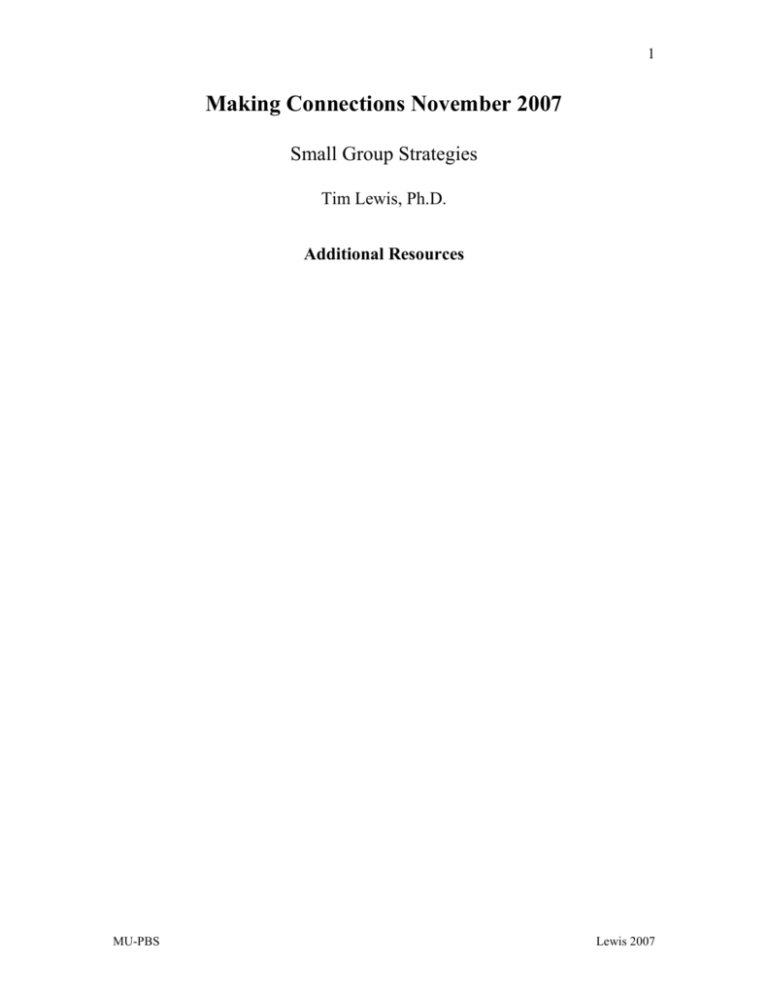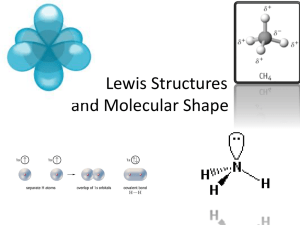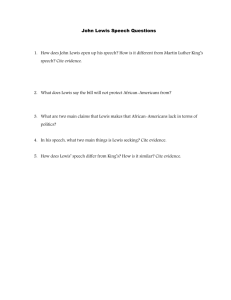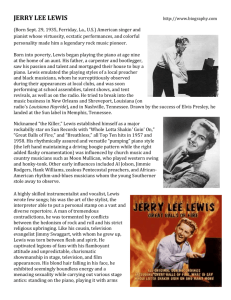Creating Classroom Systems of Support within SW-PBS
advertisement

1 Making Connections November 2007 Small Group Strategies Tim Lewis, Ph.D. Additional Resources MU-PBS Lewis 2007 2 Top 17 Classroom Management Strategies that should be emphasized in every classroom Strategy Description 1. Increase ratio of positive to negative teacher to student interactions At least 4 to 1 Positive interaction every 5 minutes Follow correction for rule violation with positive reinforcer for rule following 2. Actively Supervise at all times Move continuously Scan continuously & overtly Interact frequently & positively Positively reinforce rule following behaviors 3. Positively interact with most students during lesson Physical, verbal, visual contact Group v. individual Instructional & social 4. Manage minor (low intensity/frequency) problem behaviors positively & quickly Signal occurrence State correct response Ask student to restate/show Disengage quickly & early 5. Follow school procedures for chronic problem behaviors 6. Conduct smooth & efficient transitions between activities Be consistent & business-like Precorrect for next occurrence Taught routine Engage students immediately MU-PBS Lewis 2007 3 Strategy Description 7. Be prepared for activity Prepare filler activities Know desired outcome Have materials Practice presentation fluency 8. Begin with clear explanations of outcomes/objective 9. Allocate most time to instruction 10. Engage students in active responding 11. Give each student multiple ways to actively respond Advance organizer Point of reference Fill day with instructional activities Maximize teacher led engagement Write Verbalize Participate Individual v. choral responses Written v. gestures Peer-based 12. Regularly check for student understanding 13. End Activity with specific feedback 14. Provide specific information about what happens next 15. Know how many students met the objective/outcomes 16. Provide extra time/assistance for unsuccessful students 17. Plan for next time activity conducted Questions Affirmative gestures Written action Academic v. social Individual v. group Homework New activity Next meeting Oral Written Sample More practice More instruction Firm up outcome New outcome Test MU-PBS Lewis 2007 4 Effective Teaching Strategies • There are high rates of engaged time • There are high rates of student success • Teacher maintains student attention • There are smooth and effective transitions teach rules about transition pre-corrects & advanced organizers • Clear group rules stated positively stated succinctly stated in observable terms made public enforced small number taught • Positive climate communicate expectations for achievement safe, orderly, and focused environment for work smooth group prevention management strategies • Rapid pacing • Frequent questioning • Appropriate feedback given to students always provide immediate feedback in the acquisition phase always provide precise feedback combine feedback with instruction • There are high expectations for student learning • Incentives and rewards are used to promote excellence • Personal interactions between teachers and students are positive MU-PBS Lewis 2007 5 Promoting Positive & Effective Learning Environments Classroom Checklist (Lewis) Instruction Advanced organizers given Specific explanations and clear instructions given Lesson well paced Student attention maintained throughout lesson Opportunity for student practice Frequent and detailed positive feedback given to students Appropriate error correction and review strategies employed Classroom Management Precorrects given Active positive interactions with students Positive feedback given to students Smooth transitions between lessons/activities Differential reinforcement used appropriately Non Instructional time is kept to a minimum Positive, predictable, orderly learning environment maintained Classroom rules posted and enforced consistently and equitably Individual behavior change strategies implemented appropriately MU-PBS Lewis 2007 6 Effective Classroom Plan (Newcomer & Lewis) List Classroom Rules: 1. 2. 3. 4. 5. Are they observable, measurable, positively stated, with no question about meaning? Do the rules coincide with school-wide expectations? Identify Procedures for Teaching Classroom Rules: Record dates taught & How and when will they be taught? reviewed Identify your attention signal: Date taught Determine your daily/hourly schedule Is your schedule posted? MU-PBS Lewis 2007 7 Identify Student Routines (e.g. requesting assistance, entering class, sharpening pencils, class dismissal, passing in papers, grading papers, transitions, working with peers, etc.) List routines and steps Date Taught Identify Teacher Routines (e.g. greeting & escorting students, signaling for attention, giving directions, providing feedback or corrections, grading, etc. List routines and steps Date Taught MU-PBS Lewis 2007 8 Identify procedures for encouraging appropriate behavior: Whole Group Individual Student Identify procedures for discouraging problem behaviors MU-PBS Lewis 2007 9 ENVIRONMENTAL INVENTORY Rate each feature using the following scale: 1 = inconsistent or unpredictable ……….5 = consistent and predictable Physical Space: Is physical space organized to allow access to instructional materials? 1 2 3 4 5 Work centers are easily identified and corresponds with instruction Traffic flow minimizes physical contact between peers and 1 2 3 4 5 maximizes teacher ‘s mobility Attention: Does the teacher gain the attention of the students prior to instruction? A consistent and clear attention signal is used across instructional 1 2 3 4 5 contexts Uses a variety of techniques to gain, maintain, and regain student 1 2 3 4 5 attention to task. Time: Does the teacher initiate instructional cues and materials to gain, maintain, and regain student attention? 1 2 3 4 5 Materials are prepared and ready to go. 1 2 3 4 5 Pre-corrects are given prior to transitions. Common intrusions are anticipated and handled with a consistent procedure. Unexpected intrusions are minimized with an emphasis on 1 2 3 4 5 returning to instruction. 1 2 3 4 5 Students engaged at high rates during individual work 1 2 3 4 5 Down-time (including transitions) is minimal Behavior Management: Does the teacher have universal systems of PBS in place? 1 2 3 4 5 Rules are posted 1 2 3 4 5 Rules are referred to at appropriate times 1 2 3 4 5 Students receive verbal praise for following rules Corrections are made by restating the rule/expectation and stating the 1 2 3 4 5 appropriate replacement behavior. 1 2 3 4 5 Continuum of consequences for encouraging expected behaviors 1 2 3 4 5 Continuum of consequences for discouraging expected behaviors 1 2 3 4 5 Maintains a 4:1 ratio of positive to negative statements Routines: Does the teacher have procedures and routines that are clear and consistently followed? 1 2 3 4 5 Start of class 1 2 3 4 5 Working in groups 1 2 3 4 5 Working independently 1 2 3 4 5 Special events (movies, assemblies, snacks, parties) 1 2 3 4 5 Obtaining materials and supplies 1 2 3 4 5 Using equipment (e.g. computer, tape players) 1 2 3 4 5 Managing homework and other assignments 1 2 3 4 5 Personal belongings (e.g. coats, hats) 1 2 3 4 5 Entering/exiting classroom (e.g. using restroom/drinking fountain, going to library, moving around room MU-PBS Lewis 2007 10 Curriculum and Content: Does the teacher implement effective instruction strategies? 1 2 3 4 5 Assignments can be completed within allotted time period 1 2 3 4 5 Content presented at student level resulting in high rates of engagement 1 2 3 4 5 Frequently checks student learning for understanding 1 2 3 4 5 Instructional focus builds on student’s current and past skills 1 2 3 4 5 Gives clear set-up and directions for task completion Based on the observation, summarize strengths and weaknesses of universal PBS implementation in the classroom. MU-PBS Lewis 2007






